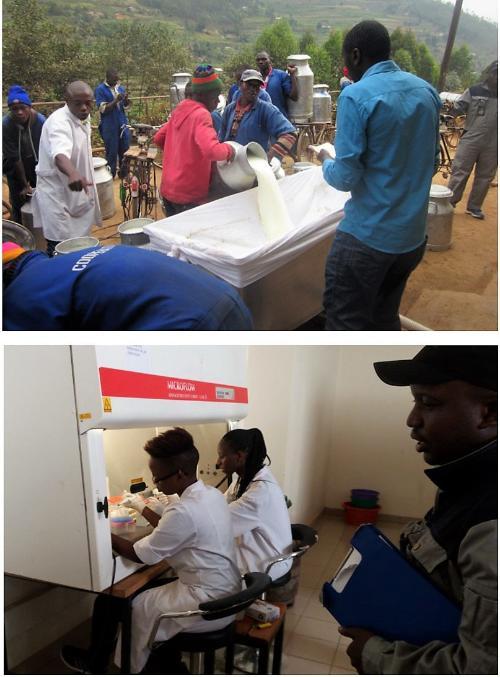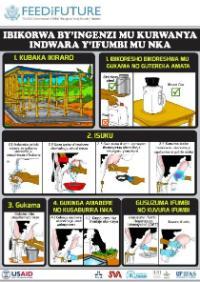Project in Rwanda
Milk Production Practices, Udder Health and Their Impact on Milk Quality, Safety and Processability in Rwanda
Timeframe: October 2016 - December 2018
Funding: USAID
Principal investigator (PI) and lead institution
Jean Baptiste Ndahetuye, University of Rwanda
Co-PI and collaborator institutions
- Renée Båge, Swedish University of Agricultural Sciences (SLU)
- National Veterinary Institute, Uppsala, Sweden: Ylva Persson, Karin Artursson
- Ann Nyman, Växa Sverige
- Juvenal Djangwani, University of Rwanda
Results
-
Ndahetuye, J.B., Leijon, M., Båge, R., Artursson, K., and Persson, Y. 2021. Genetic characterization of Staphylococcus aureus from subclinical mastitis cases in dairy cows in Rwanda. Front. Vet. Sci. 8:751229. https://doi.org/10.3389/fvets.2021.751229
- Ndahetuye, J.B. et al. June 2020. A cross sectional study of prevalence and risk factors associated with subclinical mastitis and intramammary infections, in dairy herds linked to milk collection centers in Rwanda. Preventive Veterinary Medicine, Volume 179, 105007, https://doi.org/10.1016/j.prevetmed.2020.105007
- Innovation Summary for Mastitis Control
- Ndahetuye, J.B., Artursson, K., Båge, R., Ingabire, A., Karege, C., Djangwani, J., Nyman, A.K., Ongol, M.P., Tukei, M., and Persson, Y. November 2020. MILK Symposium review: Microbiological quality and safety of milk from farm to milk collection centers in Rwanda. Journal of Dairy Science, Volume 103, Issue 11. https://doi.org/10.3168/jds.2020-18302. It is openly available.
-
Ndahetuye, J. B. 2019. Mastitis in dairy cows in Rwanda: Prevalence, aetiology, antimicrobial resistance, molecular epidemiology and effects on milk quality. Doctoral thesis. Uppsala, Sweden: Swedish University of Agricultural Sciences. https://pub.epsilon.slu.se/16465
This video, featuring an interview with Jean-Baptiste Ndahetuye, is on YouTube at https://youtu.be/vQ8mhOdtiQA (footage courtesy of the University of Florida Foundation).
Project Plan
Government of Rwanda initiatives such as Girinka have increased milk production from 185,000 tons in 2007 to 445,000 tons in 2013 and the annual milk production was projected to reach 650,000 tons by 2017. However, there are limitations in achieving the vision of high quality milk production. These include the lack of service providers and lack of research at different levels of the milk chain. Lack of research on dairy animal health and milk pre-and post-harvest best practices lead to significant qualitative and quantitative losses of milk. Lack of good quality milk hampers the efforts to fight malnutrition and can lead to public health hazards. The overall objective of the current project was to develop best practices that enhance dairy cow’s health and milk quality in the Rwandan dairy chain. Specific objectives include the following:
- Evaluate udder health, risk factors and impact of subclinical mastitis on dairy productivity in Rwanda;
- Evaluate microbiological and chemical quality of raw milk in Rwanda by evaluation of the prevalence of zoonotic bacteria, their antimicrobial resistance and the antimicrobial residues in milk at different sites of the milk chain in Rwanda; and
- Train dairy farmers, MCCs managers/technicians, IAKIB’s extension officer/veterinarians, district’s veterinarians and students in best practices for good udder health and best milk production practices. The research site will be the Gicumbi District in Northern Rwanda.
More Information
 October 2020 research update NDAHETUYE VGM (Virtual General Meeting)
October 2020 research update NDAHETUYE VGM (Virtual General Meeting)
- Poster on proper milking routine, mastitis detection and treatment (in Kinyarwanda language)
Related work by PI
Ndahetuye, J.B., Persson, Y., Nyman, AK. et al. 2019. Aetiology and prevalence of subclinical mastitis in dairy herds in peri-urban areas of Kigali in Rwanda. Trop Anim Health Prod 51, 2037–2044. https://doi.org/10.1007/s11250-019-01905-2
Feed the Future Innovation Lab for Livestock Systems is part of Feed the Future






